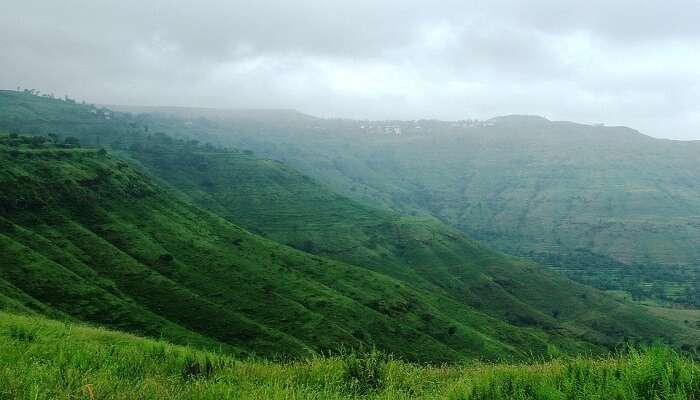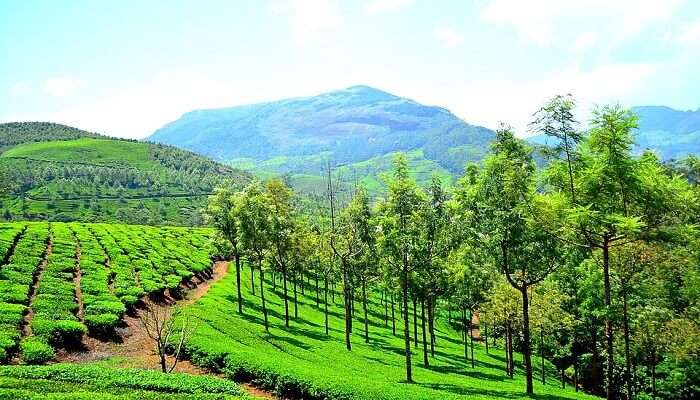Explore The Iconic Landmark Of Tashichho Dzong In Thimphu In 2025
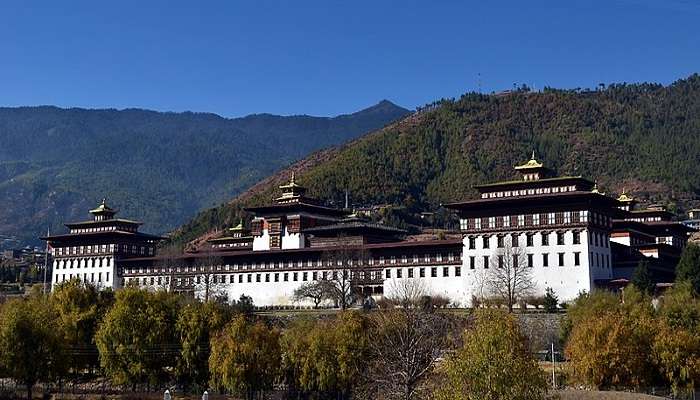
Situated on the western banks of the Wang Chu River in Thimpu, the magnificent Tashichho Dzong is a renowned monastery and a fortress that also serves as the seat of the government. Beautiful gardens surround this impressive edifice and is close to Thimphu. It houses 30 temples, shrines, and chapels, along with the throne room and offices of the king and government ministries. Visit this iconic landmark to discover the historical and architectural significance of Bhutan. Immerse yourself in the rich tapestry of cultural and spiritual treasures as you tour this magnificent site.
History Of Tashichho Dzong
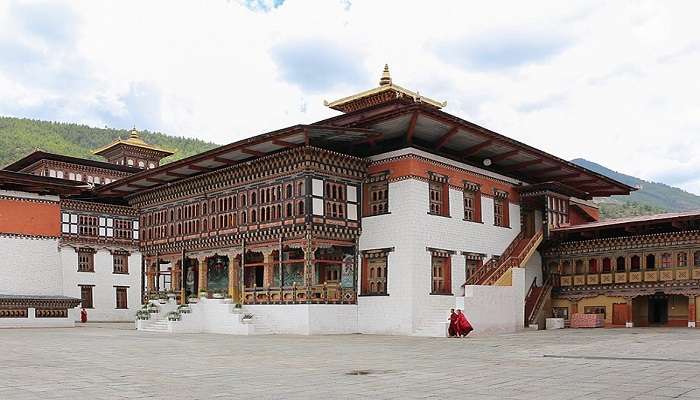
The Tashichho Dzong has an intriguing history dating back to the 13th century. In 1216 A.D., the Dzong was constructed by Lama Gyalwa Lhanapa as a building of Bluestone named Dho-Ngon-Dzong. In 1641, when Zhabdrung Ngawang Namgyal defeated the followers of Lama Gyalwa Lhanapa, he took over the Dzong and reconstructed and named it Tashichho Dzong. The monastery served as a summer residence to a monastic body headed by Shabdrung Rinpoche. Desi Tenzin Rabgaye further improved the fortress in 1694 to make it even larger. After that, the monastery was renovated several times after being gutted in fire on two occasions, once in 1698 and later in 1741.
Also Read: Places To Visit In Paro
Architecture Of Tashichho Dzong
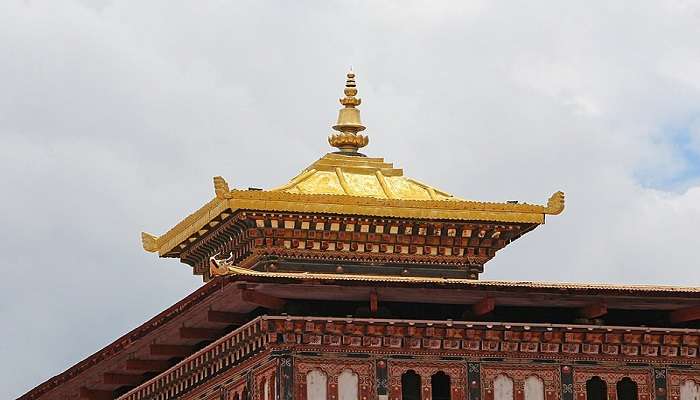
An architectural marvel, the Tashichho Dzong is an iconic edifice representing Bhutan’s traditional style. Built without nails, the remarkable woodwork testifies to the architectural brilliance, further accentuated by the two courtyards and the central tower known as Utse rising majestically. Divided into three parts, that is the King’s office, the administration block, and a spiritual section, the entire structure is a harmonious blend of spiritual and administrative spaces. Further adding to the spiritual ambience of this sacred monastery and offering a spiritual and artistic delight to the art connoisseurs are the stunning murals adorning the walls and showcasing Buddhist teachings. Visiting this architectural masterpiece is truly a remarkable experience, allowing visitors to experience Bhutan’s rich legacy of culture and tradition.
Places To Visit Near Tashichho Dzong
Now that you have visited the beautiful Taschichho Dazong, you know the cultural heritage and history of the fortresses and monasteries. Here is a list of places you should visit for a historical exploration of Bhutan; this will make your vacation worthwhile.
1. Memorial Chorten
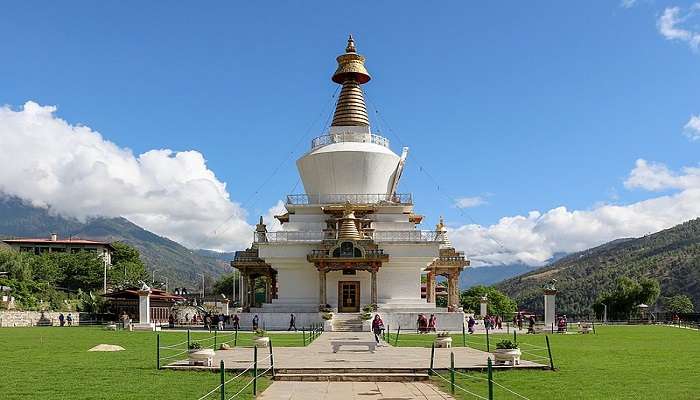
Situated in the southern-central part of Thimphu, the Memorial Chorten is one of the famous tourist attractions in Thimphu. Easily viewed from a distance, this gleaming white-washed stupa with a golden spire was built in 1974 in honour of the third king, Jigme Dorji Wangchuck. Representing peace and tranquillity, this stupa is home to a distinctive collection of religious paintings and Buddhist statues. The entrance of the chorten has three Bodhisattvas; each bodhisattva symbolises compassion (through Avalokiteshvara), knowledge (through Manjushri), and power (through Vajrapani). The giant prayer wheel, which is the main attraction of the Chorten, is placed at the main entry gate. A visit to this cultural landmark fills one with peace and tranquillity.
Distance from Tashichho Dzong: 3.3kilometers
Timings: Summer: Mon-Fri: 5:30 A.M.-6:30 P.M.; Sat-Sun: 8:00 A.M.-5:00 P.M.; Winter: 8:00 A.M.-5:00 P.M.
Entry Fee: Foreigners: BTN 300; Students: BTN 150
Related Post: Tourist Places In Bhutan
2. Buddha Dordenma
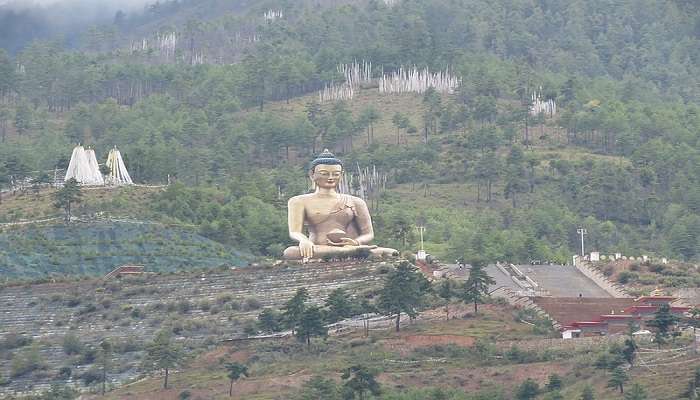
Overlooking the capital city of Thimphu, the colossal Buddha Dordenma is regarded as one of the largest Buddha statues in the world. The statue’s construction was completed in 2015 and dedicated to Jigme Singye Wangchuck, the fourth king’s 60th anniversary. Perched on a hill in Kuensel Phodrang Nature Park, this three-story Buddha statue stands at a height of 177 feet, and what is truly amazing is that inside the statue, there are 125,000 smaller Buddha statues ranging between 8 to 12 inches in height. This magnificent statue is an artistic marvel and the epitome of Bhutan’s rich cultural Buddhist heritage.
Distance from Tashichho Dzong: 7.7 kilometres
Timings:
Entry Fee: No entry fee
3. Folk Heritage Museum of Thimphu
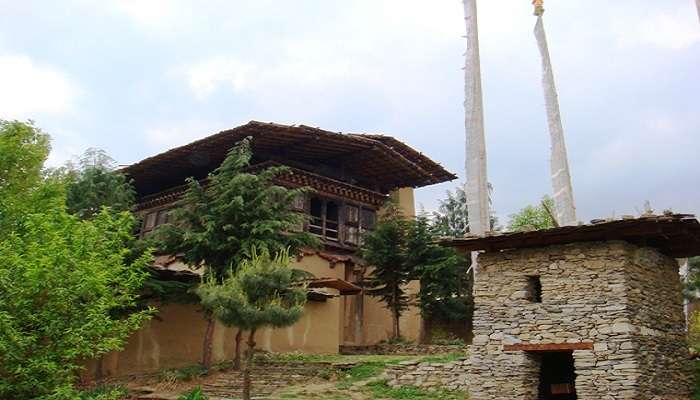
Constructed in 2001, the Folk Heritage Museum of Thimphu offers a glimpse into the rural life of Bhutan. Situated within a 19-century three-storey farmhouse, you will discover different elements of Bhutan’s culture and heritage as a visitor. It is a fascinating experience to browse through different exhibits depicting rural life such as household items, farming equipment, traditional tools and various interesting artefacts. If you really want to witness Bhutan’s cultural legacy and understand its rural customs, visiting this museum is a must that unfolds before you layers of cultural richness embedded in the agrarian lifestyle of its people.
Distance from Tashichho Dzong: 1.5 kilometres
Timings: Tuesday-Friday: 10:00 A.M. to 04:00 P.M.; Saturday-Sunday: 10:00 A.M. to 3:00 P.M.
Entry Fee: BTN 150
Related Post: Homestays In Bhutan
4. Simtokha Dzong

Nestled on the scenic hills of Thimphu, the Simtokha Dzong is also known as the Sangak Zabdhon Phodrang and the monastery was built to promote Buddhism and guard against enemies from the south. The locals believe it is one of the first Dzong built in Bhutan, offering a spiritual and tranquil environment. Simtokha means “ Atop a Demon”, and the main purpose of building the Dzong was to frighten the evil spirit. The Simtokha Dzong was built by Zhabdrung Ngawang Namgyal in 1629. The Central Tower of the Dzong is the main highlight. It has 12 sides, and quite a few shrines depict Buddhist deities and teachings. The Dzong is one of the splendid tourist attractions in Thimphu and looks particularly stunning in the evenings when lit up.
Distance from Tashichho Dzong: 8.2 kilometres
Timings: 9:00 A.M. to 5:00 P.M.
Entry Fee: No entry fee
5. Changangkha Lhakhang
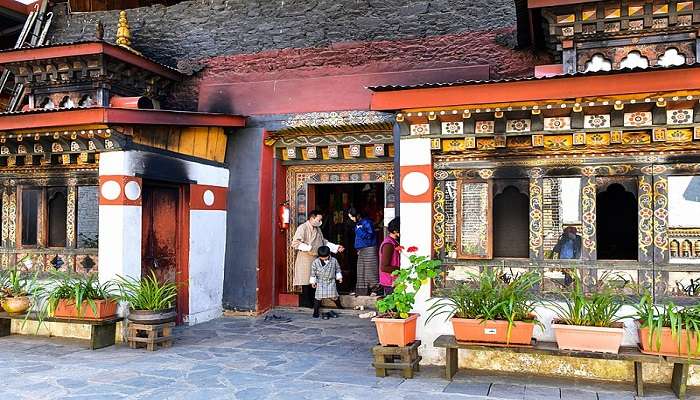
Located 1 kilometre from Thimphu downtown, Changangkha Lakhang is an ancient temple built during the 12th century by Phajo Drugom Shigpo, who was the founder of the Drukpa ancestry in Bhutan. This monastery is beautifully situated on the edge of Thimphu Valley. At the entrance gate of the monastery, there is a huge portrait of the King, and as a gesture of respect, everyone is expected to bow down. Several statues of significant people are a major attraction of the temple, such as the statue of Zhabdrung Ngawang Namgyal and the Statue of Chenrezig, which has 11 heads and a thousand arms. The temple’s architecture is truly magnificent, depicting intricate murals, impeccable woodwork and prayer wheels that contribute to the sacredness of the place, creating a peaceful spiritual aura.
Distance from Tashichho Dzong: 3.0 kilometres
Timings: 9:00 A.M. to 5:00 P.M.
Entry Fee: No entry fee
You May Also Like To Read: Monasteries In Bhutan
Thimphu, the capital of Bhutan, is famous for its scenic vistas and cultural heritage, including the Tashichho Dzong. A visit to this historical monastery gives you a glimpse of Bhutan’s cultural heritage. Besides the Tashichho Dzong, you can find many tourist attractions, such as the Memorial Chorten, Museum, and other Dzongs nearby. Your trip to Thimphu is incomplete without visiting these cultural places mentioned above.
For our editorial codes of conduct and copyright disclaimer, please click here.
Cover Image credit: By Christopher J. Fynn for Wikimedia Commons.
Frequently Asked Questions About Tashichho Dzong
Why is Tashichho Dzong important?
Since the creation of the monarchy in 1907 the Dzong has been the official seat of the Druk Desi, the head of Bhutan’s civil government.
What are the Tashichho Dzong timings?
The Tashichho Dzong timings are after 5 P.M. when the government offices close but the timings of the fortress are Monday to Sunday: 11:00 A.M. to 04:00 P.M.
What is the Tashichho Dzong entry fee?
The entry fee for visiting the Tashichho Dzong is BTN 300.
How to reach the Tashichho Dzong?
The only international airport is in Paro which is 54 kilometres from Thimphu. After reaching the airport you can hire a car that will take you to the Tashichho Dzong.
What is the best time to visit Thimphu?
The Autumn season (September-November) is the best time to visit Thimphu, Bhutan. The skies are clear and you can experience pleasant weather.
People Also Read:
Monasteries In Thailand Monasteries In Ladakh Buddhist Monasteries In India

With a passion for exploring and travelling to the roads long forgotten, experience the world through enthralling stories and adventures. Join me as I share my experiences at some of the world’s most popular tourist destinations and quench that pestering curiosity with something exciting!



